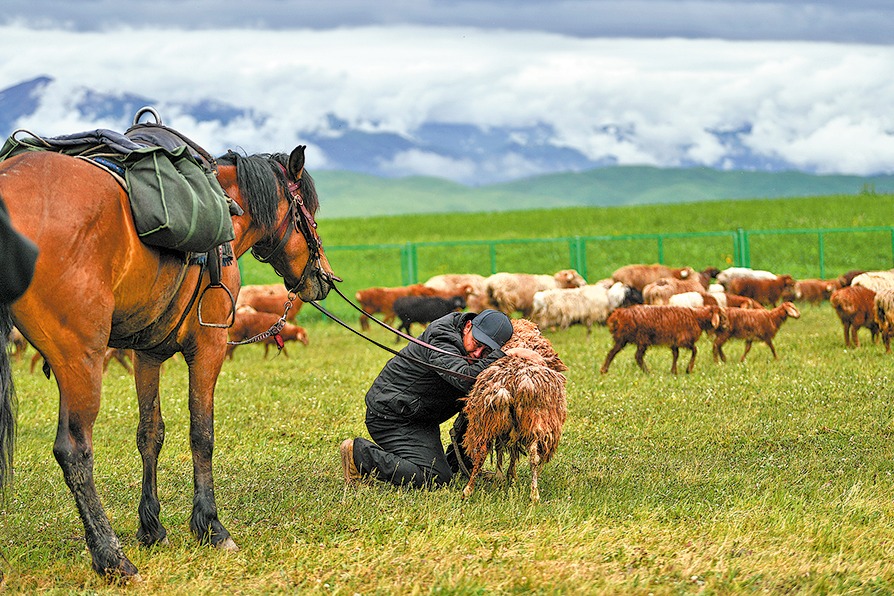Researchers help nurture nature's 'punks'


Yunnan snub-nosed monkeys come in from the cold to a warm welcome, report Cheng Yuezhu in Beijing and Li Yingqing in Kunming.
If you visit the Baima Snow Mountain National Nature Reserve, Yunnan province, you might encounter the "elves of the snow mountains".
These are, in fact, Yunnan snub-nosed monkeys. Living in the primary forests deep in the mountains, they seem to have a unique sense of fashion, with distinctive pink, pouting lips and a devil-may-care "punk hairdo".
In Xiangguqing village, inside the nature reserve, tourists can see them playing in the woods. The young swing in a carefree manner from branch to branch. The females embrace their silver-haired infants tightly, while the leading male sits majestically on a tree surveying the family and all around him.
However, back in the 1980s, it was difficult for zoologist Long Yongcheng to even find the elusive animal and take a clear photo, let alone closely observe them.
Long began to work at the Kunming Institute of Zoology in 1982.In 1985, a trip to Dechen Tibet autonomous prefecture in northwestern Yunnan led him to a lifelong bond with this endangered species.
There were no existing photographs when the Baima Snow Mountain nature reserve was established in 1983. The staff members didn't even know what the monkeys looked like. Many thought they were golden in appearance, like the Sichuan snub-nosed monkey, and called the real Yunnan snub-nosed monkeys "white monkeys" or "bicolor monkeys".
"The infrastructure was inadequate and the staff didn't understand the animal well. I thought, this place needs me more than other reserves. Here I can make a difference," Long says.
From then to 1994, Long and his two assistants, Zhong Tai and Xiao Lin, both of whom were the first staff members of the reserve, trekked through the mountains searching for Yunnan snub-nosed monkeys. They followed the spoor and consulted villagers living deep in the mountains to tap into local knowledge.
They located 20 groups of the monkeys, totaling about 1,500, living in the more than 600,000-hectare primary forests between the Jinsha and Lancang rivers.
At first, it was rare to even find the animals, as the locals used to hunt the monkeys before the nature reserve was established. The monkeys fled at the sight of humans. The researchers had spotted white fleeting shadows in the deep trees, but it wasn't until 1992 that Long managed to take a clear photo of the monkey that revealed to the world its true appearance.
But some were even less lucky. Xiao wrote in his book Shoushan (Guarding Mountain) that in the eight years since he arrived at the reserve in 1983, he never even laid eyes on one.
The Kunming Institute of Zoology started building a monkey observation station marking the first-ever systematic study of Yunnan snub-nosed monkeys. The station was set up in 1992 where Long first spotted the primates, 4,300 meters above sea level, a difficult environment even for Zhong and Xiao, who are of Tibetan ethnic group.
The researchers often went on 15-day field trips. They carried all their supplies, including food, cameras and essentials, weighing more than 20 kilograms, which meant that they couldn't carry a tent and, therefore, had to sleep in the open.
Gradually they learned to follow the spoor, hide in the distance and observe them quietly.
From those observations, the researchers recorded the habits of the monkeys, including that they feed on usnea (a type of lichen) and live in family groups, and each family has a strict hierarchy with a leading male.
An important factor was the local hunters, who served as guides with their detailed knowledge and experience of the local geography and fauna. Some of them even joined the wildlife protection efforts.
Yu Jianhua, 69, from Yunnan's Weixi Lisu autonomous county is a hunter-turned-protector, who has now worked at the reserve for 25 years.
"I first saw the Yunnan snub-nosed monkey when I was about 17. At that time, I went hunting with my grandfather in the mountains and saw one. My grandfather told me that we can't hunt monkeys, that they are the ancestors of humans. So I never hunted the snub-nosed monkey or any other monkey," Yu says.
When Weixi county's forestry bureau decided to establish a forest patrol team in 1997, Li Hu, the director at the time, found Yu and asked him to join.
Yu answered the call and became the team leader, patrolling the mountains daily. "Although I was a hunter, I actually quite like animals. It's just that I never had any education. So when the director told me that snub-nosed monkeys are a protected animal, I wanted to do this."
For a daily subsidy of mere 6 yuan ($0.9), Yu worked in Xiangguqing village inside the nature reserve for 12 years. Then, the nature reserve set up a monkey safeguard team with specialized funding and improved benefits for Yu and other team members. It has now expanded from four people to a team of 28. Yu continues to be the leader.
"Now, the locals and hunters have all become protectors of the monkeys, and they don't fear humans that much. Our research has become easier, and we can observe and study them closely," Long says.
Xiangguqing village is the only spot where people can see the Yunnan snub-nosed monkeys. It has 10 monkey families, with a total number of more than 70. The monkeys have trust in the team and they emerge from the trees when hearing the guardians' calls.
A book on the conservation of Yunnan snub-nosed monkeys was published last year, showing that their number has increased to more than 3,800.
Comparing the maps of primate animals and human habitats in China, Long notes that most of the regions favored by primates and humans coincide.
"Because we are all primates, the places disagreeable to primates are also disliked by humans. Protect the Yunnan snub-nosed monkeys, and we are safeguarding ecological security and constructing ecological civilization," Long says.
"The Yunnan snub-nosed monkey is endemic to China, so it's a symbol of China and we are 100 percent responsible for its protection. To me, it is the most beautiful animal in the world. I hope that in my lifetime, more people will get to know how precious it is, and that it will be equally adored as the giant panda."
Related: Yunnan snub-nosed monkey receives a warm welcome




































